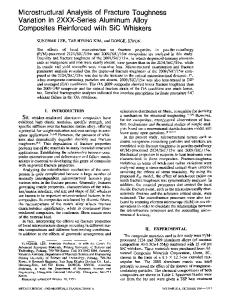Optimization of the strength-fracture toughness relation in particulate-reinforced aluminum composites via control of th
- PDF / 1,742,357 Bytes
- 14 Pages / 612 x 792 pts (letter) Page_size
- 0 Downloads / 320 Views
INTRODUCTION
DISCONTINUOUSLY reinforced aluminum (DRA) composites are promising candidates for a number of aerospace and automotive applications, because they display significantly higher stiffness-to-weight and strength-to-weight ratios and possess better wear resistance and elevatedtemperature properties than unreinforced aluminum alloys. However, DRA composites typically have a low fracture toughness relative to unreinforced aluminum. It has recently become quite apparent that, unless the intrinsic fracture toughness of DRA can be systematically and predictably improved, its acceptance as a reliable structural material will not be forthcoming. Several detailed studies and reviews of the fracture behavior of DRA have been published during the last decade.[1–12] A number of different microstructural variables, including the volume fraction,[4,9,16] size,[4] shape,[14,15,16] and spatial distribution of the reinforcement phase,[2,9,13,18] as well as the details of the matrix microstructure[2,9,17–20] and interface composition,[2,21] have been shown to play important roles in determining the deformation and fracture behavior of DRA. Two different fracture mechanisms have been commonly observed in DRA in the absence of interfacial damage (e.g., References 9 and 19). In composites with matrices having high strength and a relatively low work hardening rate (e.g., in the artificially peak-aged condition), fracture is typically I. DUTTA, Associate Professor of Materials Science, T.R. McNELLEY, Professor of Materials Science, and R. NAGARAJAN, NRC Postdoctoral Research Associate, are with the Department of Mechanical Engineering, Naval Postgraduate School, Monterey, CA 93943. F.N. QUILES, formerly Graduate Student, Department of Mechanical Engineering, Naval Postgraduate School, is with the United States Navy. Manuscript submitted June 19, 1997. METALLURGICAL AND MATERIALS TRANSACTIONS A
dominated by the crack nucleation event, which occurs by particle cracking accompanied by a high degree of strain localization. In this case, particle cracking is rapidly followed by final fracture. On the other hand, in composites with relatively soft matrices and a high work hardening rate (e.g., in the naturally aged condition), the extent of strain localization is limited, and significant tensile ductility may be obtained following the initial particle fracture events.[9,19] In general, damage initiation is most likely to begin either by cracking of the larger particles[2,4,9,19,22] or by matrix microvoid nucleation and growth within clusters of small particles.[9,11] Preferential cracking of the larger particles is thought to be associated with the increased flaw density in large particles in conjunction with the increased local stress supported by large particles,[2,4,9,19] whereas matrix cracking within clusters is attributable to the presence of large hydrostatic tension between clustered particles.[9,11] Additionally, damage may initiate by facile nucleation of microvoids at incoherent precipitates at particle-matrix interfaces,
Data Loading...











